ABC Assessment Tool for Children with Learning Difficulties
VerifiedAdded on 2023/06/03
|11
|2994
|86
AI Summary
This article discusses the use of ABC assessment tool for young children facing learning difficulties. It covers the population, problem, issue, outcome, research question, search plan, and search strategy. The article also provides information on the psychometric properties and clinical utility of the measurement tool, as well as its suitability for the clinical scenario. The final decision recommends the use of the tool with caution. The article includes a reference list and attachments.
Contribute Materials
Your contribution can guide someone’s learning journey. Share your
documents today.

University
Assignment
Student name
Study unit
Assignment
Student name
Study unit
Secure Best Marks with AI Grader
Need help grading? Try our AI Grader for instant feedback on your assignments.

Appendix iv)
OTHY104: Assessment 2: Measurement evaluation related to occupational therapy
clinical scenario
Developing Your Research Question
Population/Problem
Children facing learning challenges
Issue - assessment/outcome measure
ABC tool assessment on the developmental disorder
Outcome
To assess the reliability, validity and clinical utility of the tool
Research Question
ABC assessment form on young children facing learning difficulties
Search Plan (write down your search terms including synonyms, truncations etc.).
Population Issue/measurement
tool
Comparison Outcome
Children patients ABC assessment
tool
The effectiveness of the
tool
Search Strategy
This search will employ three search databases which include CINAHL, Medline Complete, AND
PubMed. CINAHL and CINAHL are essential databases which provide full-text nursing articles
and other allied journals. Pub Med is the largest US national library having medical related
journals and studies. These three databases were selected for the sole purpose of obtaining
quality studies document on the topic of interest and in reviewing occupational therapy cases
based on ABC tool. These databases are relevant for the clinical question because they have a
large large pool of scientific data in the medical filed being published and posted there, hence
increases the chance of getting high-quality studies and results related to my clinical question.
The search was conducted in the three search databases. In searching was done using key
terms and alterations made using Boolean operators to increase search results. The research
data obtained was filtered to be between 2011-2018. Qualitative studies were selected and
retrieved for the purpose of answering the research question.
Measurement Tool: Identify Relevant Articles
Reference for measurement tool (use APA
6th).
The study was crucial to my search in that it
involved assessment of learning using ABC
braille study.
1. Sacks, S. Z., Hannan, C. K., & Erin, J. N.
(2011). Children's perceptions of learning
braille: qualitative and quantitative findings of
the ABC Braille Study. Journal of Visual
OTHY104: Assessment 2: Measurement evaluation related to occupational therapy
clinical scenario
Developing Your Research Question
Population/Problem
Children facing learning challenges
Issue - assessment/outcome measure
ABC tool assessment on the developmental disorder
Outcome
To assess the reliability, validity and clinical utility of the tool
Research Question
ABC assessment form on young children facing learning difficulties
Search Plan (write down your search terms including synonyms, truncations etc.).
Population Issue/measurement
tool
Comparison Outcome
Children patients ABC assessment
tool
The effectiveness of the
tool
Search Strategy
This search will employ three search databases which include CINAHL, Medline Complete, AND
PubMed. CINAHL and CINAHL are essential databases which provide full-text nursing articles
and other allied journals. Pub Med is the largest US national library having medical related
journals and studies. These three databases were selected for the sole purpose of obtaining
quality studies document on the topic of interest and in reviewing occupational therapy cases
based on ABC tool. These databases are relevant for the clinical question because they have a
large large pool of scientific data in the medical filed being published and posted there, hence
increases the chance of getting high-quality studies and results related to my clinical question.
The search was conducted in the three search databases. In searching was done using key
terms and alterations made using Boolean operators to increase search results. The research
data obtained was filtered to be between 2011-2018. Qualitative studies were selected and
retrieved for the purpose of answering the research question.
Measurement Tool: Identify Relevant Articles
Reference for measurement tool (use APA
6th).
The study was crucial to my search in that it
involved assessment of learning using ABC
braille study.
1. Sacks, S. Z., Hannan, C. K., & Erin, J. N.
(2011). Children's perceptions of learning
braille: qualitative and quantitative findings of
the ABC Braille Study. Journal of Visual
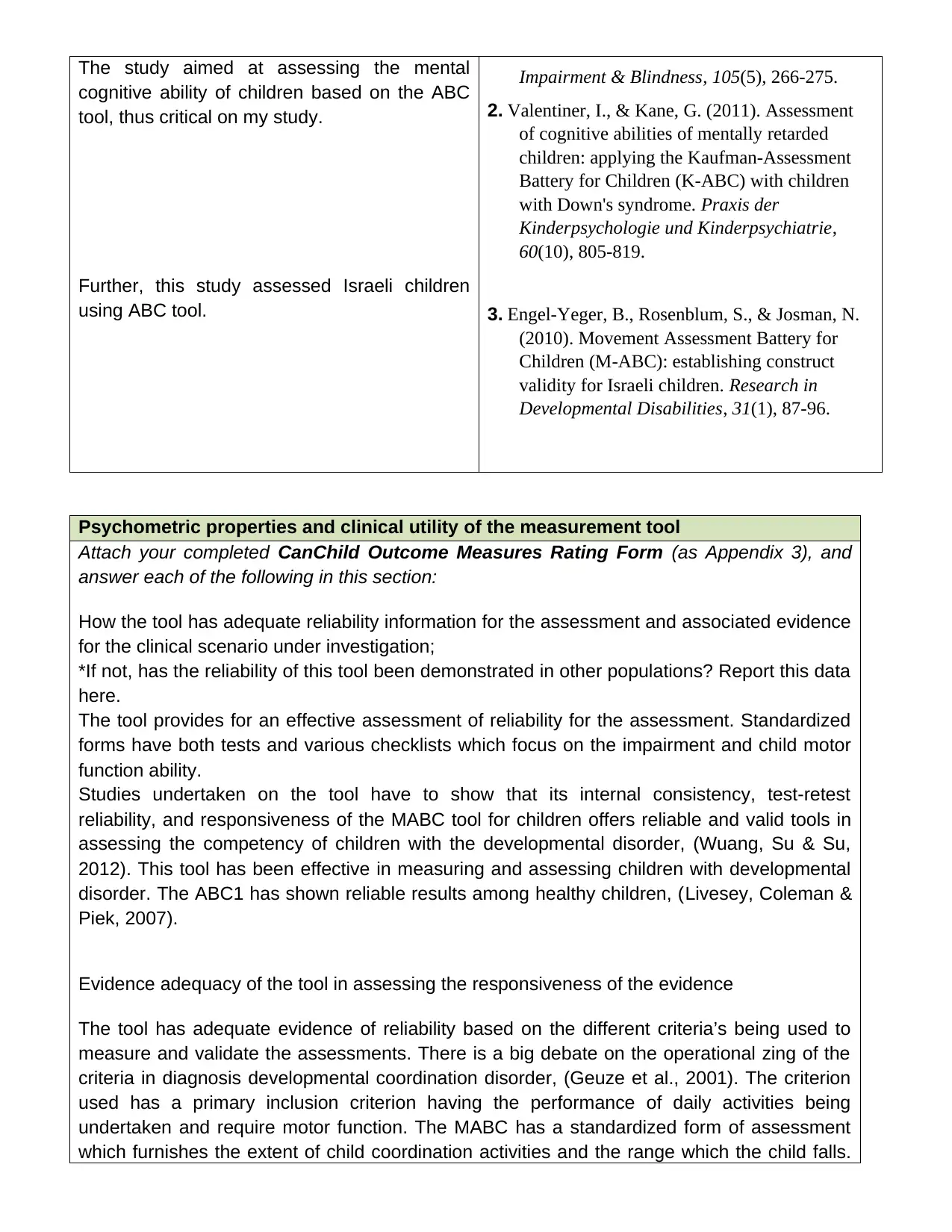
The study aimed at assessing the mental
cognitive ability of children based on the ABC
tool, thus critical on my study.
Further, this study assessed Israeli children
using ABC tool.
Impairment & Blindness, 105(5), 266-275.
2. Valentiner, I., & Kane, G. (2011). Assessment
of cognitive abilities of mentally retarded
children: applying the Kaufman-Assessment
Battery for Children (K-ABC) with children
with Down's syndrome. Praxis der
Kinderpsychologie und Kinderpsychiatrie,
60(10), 805-819.
3. Engel-Yeger, B., Rosenblum, S., & Josman, N.
(2010). Movement Assessment Battery for
Children (M-ABC): establishing construct
validity for Israeli children. Research in
Developmental Disabilities, 31(1), 87-96.
Psychometric properties and clinical utility of the measurement tool
Attach your completed CanChild Outcome Measures Rating Form (as Appendix 3), and
answer each of the following in this section:
How the tool has adequate reliability information for the assessment and associated evidence
for the clinical scenario under investigation;
*If not, has the reliability of this tool been demonstrated in other populations? Report this data
here.
The tool provides for an effective assessment of reliability for the assessment. Standardized
forms have both tests and various checklists which focus on the impairment and child motor
function ability.
Studies undertaken on the tool have to show that its internal consistency, test-retest
reliability, and responsiveness of the MABC tool for children offers reliable and valid tools in
assessing the competency of children with the developmental disorder, (Wuang, Su & Su,
2012). This tool has been effective in measuring and assessing children with developmental
disorder. The ABC1 has shown reliable results among healthy children, (Livesey, Coleman &
Piek, 2007).
Evidence adequacy of the tool in assessing the responsiveness of the evidence
The tool has adequate evidence of reliability based on the different criteria’s being used to
measure and validate the assessments. There is a big debate on the operational zing of the
criteria in diagnosis developmental coordination disorder, (Geuze et al., 2001). The criterion
used has a primary inclusion criterion having the performance of daily activities being
undertaken and require motor function. The MABC has a standardized form of assessment
which furnishes the extent of child coordination activities and the range which the child falls.
cognitive ability of children based on the ABC
tool, thus critical on my study.
Further, this study assessed Israeli children
using ABC tool.
Impairment & Blindness, 105(5), 266-275.
2. Valentiner, I., & Kane, G. (2011). Assessment
of cognitive abilities of mentally retarded
children: applying the Kaufman-Assessment
Battery for Children (K-ABC) with children
with Down's syndrome. Praxis der
Kinderpsychologie und Kinderpsychiatrie,
60(10), 805-819.
3. Engel-Yeger, B., Rosenblum, S., & Josman, N.
(2010). Movement Assessment Battery for
Children (M-ABC): establishing construct
validity for Israeli children. Research in
Developmental Disabilities, 31(1), 87-96.
Psychometric properties and clinical utility of the measurement tool
Attach your completed CanChild Outcome Measures Rating Form (as Appendix 3), and
answer each of the following in this section:
How the tool has adequate reliability information for the assessment and associated evidence
for the clinical scenario under investigation;
*If not, has the reliability of this tool been demonstrated in other populations? Report this data
here.
The tool provides for an effective assessment of reliability for the assessment. Standardized
forms have both tests and various checklists which focus on the impairment and child motor
function ability.
Studies undertaken on the tool have to show that its internal consistency, test-retest
reliability, and responsiveness of the MABC tool for children offers reliable and valid tools in
assessing the competency of children with the developmental disorder, (Wuang, Su & Su,
2012). This tool has been effective in measuring and assessing children with developmental
disorder. The ABC1 has shown reliable results among healthy children, (Livesey, Coleman &
Piek, 2007).
Evidence adequacy of the tool in assessing the responsiveness of the evidence
The tool has adequate evidence of reliability based on the different criteria’s being used to
measure and validate the assessments. There is a big debate on the operational zing of the
criteria in diagnosis developmental coordination disorder, (Geuze et al., 2001). The criterion
used has a primary inclusion criterion having the performance of daily activities being
undertaken and require motor function. The MABC has a standardized form of assessment
which furnishes the extent of child coordination activities and the range which the child falls.
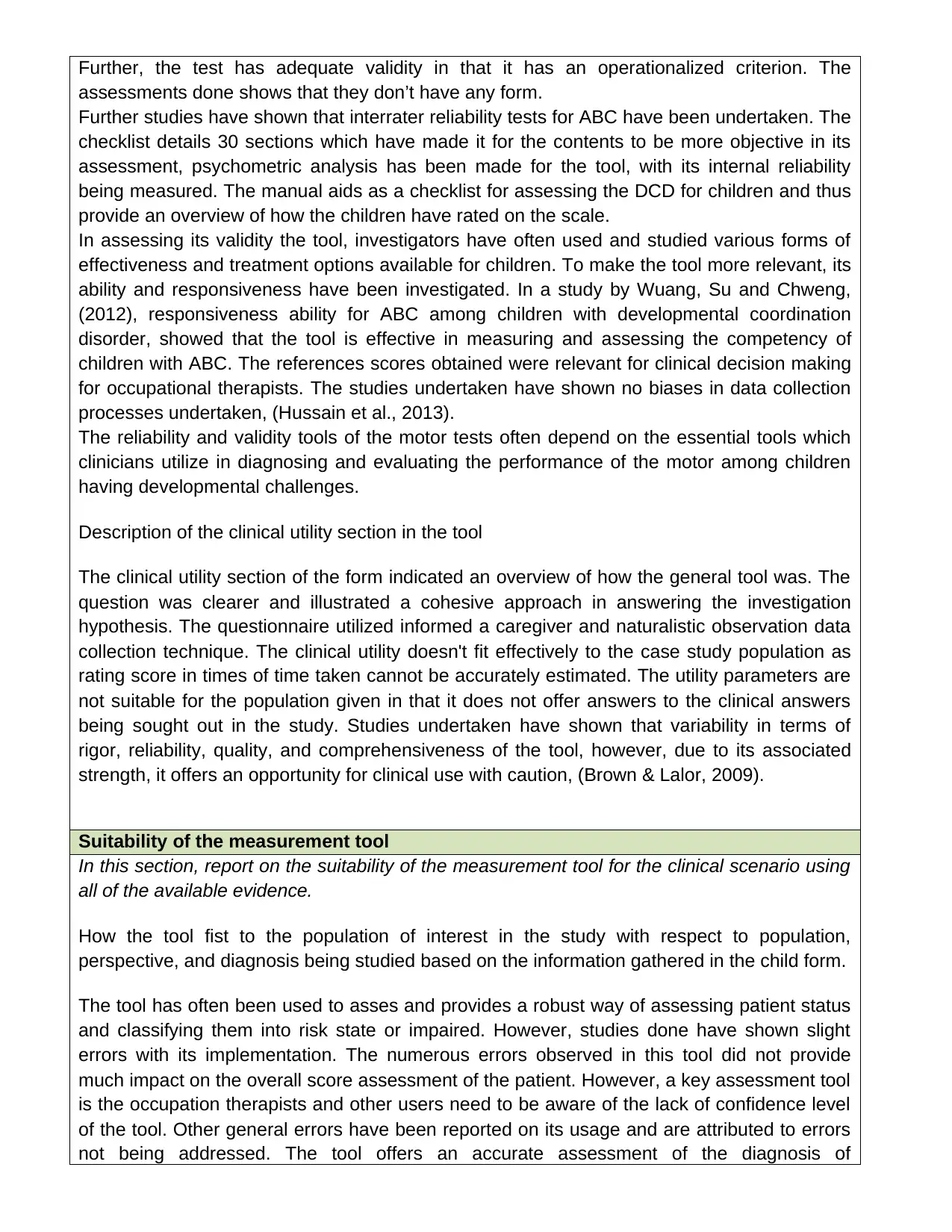
Further, the test has adequate validity in that it has an operationalized criterion. The
assessments done shows that they don’t have any form.
Further studies have shown that interrater reliability tests for ABC have been undertaken. The
checklist details 30 sections which have made it for the contents to be more objective in its
assessment, psychometric analysis has been made for the tool, with its internal reliability
being measured. The manual aids as a checklist for assessing the DCD for children and thus
provide an overview of how the children have rated on the scale.
In assessing its validity the tool, investigators have often used and studied various forms of
effectiveness and treatment options available for children. To make the tool more relevant, its
ability and responsiveness have been investigated. In a study by Wuang, Su and Chweng,
(2012), responsiveness ability for ABC among children with developmental coordination
disorder, showed that the tool is effective in measuring and assessing the competency of
children with ABC. The references scores obtained were relevant for clinical decision making
for occupational therapists. The studies undertaken have shown no biases in data collection
processes undertaken, (Hussain et al., 2013).
The reliability and validity tools of the motor tests often depend on the essential tools which
clinicians utilize in diagnosing and evaluating the performance of the motor among children
having developmental challenges.
Description of the clinical utility section in the tool
The clinical utility section of the form indicated an overview of how the general tool was. The
question was clearer and illustrated a cohesive approach in answering the investigation
hypothesis. The questionnaire utilized informed a caregiver and naturalistic observation data
collection technique. The clinical utility doesn't fit effectively to the case study population as
rating score in times of time taken cannot be accurately estimated. The utility parameters are
not suitable for the population given in that it does not offer answers to the clinical answers
being sought out in the study. Studies undertaken have shown that variability in terms of
rigor, reliability, quality, and comprehensiveness of the tool, however, due to its associated
strength, it offers an opportunity for clinical use with caution, (Brown & Lalor, 2009).
Suitability of the measurement tool
In this section, report on the suitability of the measurement tool for the clinical scenario using
all of the available evidence.
How the tool fist to the population of interest in the study with respect to population,
perspective, and diagnosis being studied based on the information gathered in the child form.
The tool has often been used to asses and provides a robust way of assessing patient status
and classifying them into risk state or impaired. However, studies done have shown slight
errors with its implementation. The numerous errors observed in this tool did not provide
much impact on the overall score assessment of the patient. However, a key assessment tool
is the occupation therapists and other users need to be aware of the lack of confidence level
of the tool. Other general errors have been reported on its usage and are attributed to errors
not being addressed. The tool offers an accurate assessment of the diagnosis of
assessments done shows that they don’t have any form.
Further studies have shown that interrater reliability tests for ABC have been undertaken. The
checklist details 30 sections which have made it for the contents to be more objective in its
assessment, psychometric analysis has been made for the tool, with its internal reliability
being measured. The manual aids as a checklist for assessing the DCD for children and thus
provide an overview of how the children have rated on the scale.
In assessing its validity the tool, investigators have often used and studied various forms of
effectiveness and treatment options available for children. To make the tool more relevant, its
ability and responsiveness have been investigated. In a study by Wuang, Su and Chweng,
(2012), responsiveness ability for ABC among children with developmental coordination
disorder, showed that the tool is effective in measuring and assessing the competency of
children with ABC. The references scores obtained were relevant for clinical decision making
for occupational therapists. The studies undertaken have shown no biases in data collection
processes undertaken, (Hussain et al., 2013).
The reliability and validity tools of the motor tests often depend on the essential tools which
clinicians utilize in diagnosing and evaluating the performance of the motor among children
having developmental challenges.
Description of the clinical utility section in the tool
The clinical utility section of the form indicated an overview of how the general tool was. The
question was clearer and illustrated a cohesive approach in answering the investigation
hypothesis. The questionnaire utilized informed a caregiver and naturalistic observation data
collection technique. The clinical utility doesn't fit effectively to the case study population as
rating score in times of time taken cannot be accurately estimated. The utility parameters are
not suitable for the population given in that it does not offer answers to the clinical answers
being sought out in the study. Studies undertaken have shown that variability in terms of
rigor, reliability, quality, and comprehensiveness of the tool, however, due to its associated
strength, it offers an opportunity for clinical use with caution, (Brown & Lalor, 2009).
Suitability of the measurement tool
In this section, report on the suitability of the measurement tool for the clinical scenario using
all of the available evidence.
How the tool fist to the population of interest in the study with respect to population,
perspective, and diagnosis being studied based on the information gathered in the child form.
The tool has often been used to asses and provides a robust way of assessing patient status
and classifying them into risk state or impaired. However, studies done have shown slight
errors with its implementation. The numerous errors observed in this tool did not provide
much impact on the overall score assessment of the patient. However, a key assessment tool
is the occupation therapists and other users need to be aware of the lack of confidence level
of the tool. Other general errors have been reported on its usage and are attributed to errors
not being addressed. The tool offers an accurate assessment of the diagnosis of
Secure Best Marks with AI Grader
Need help grading? Try our AI Grader for instant feedback on your assignments.
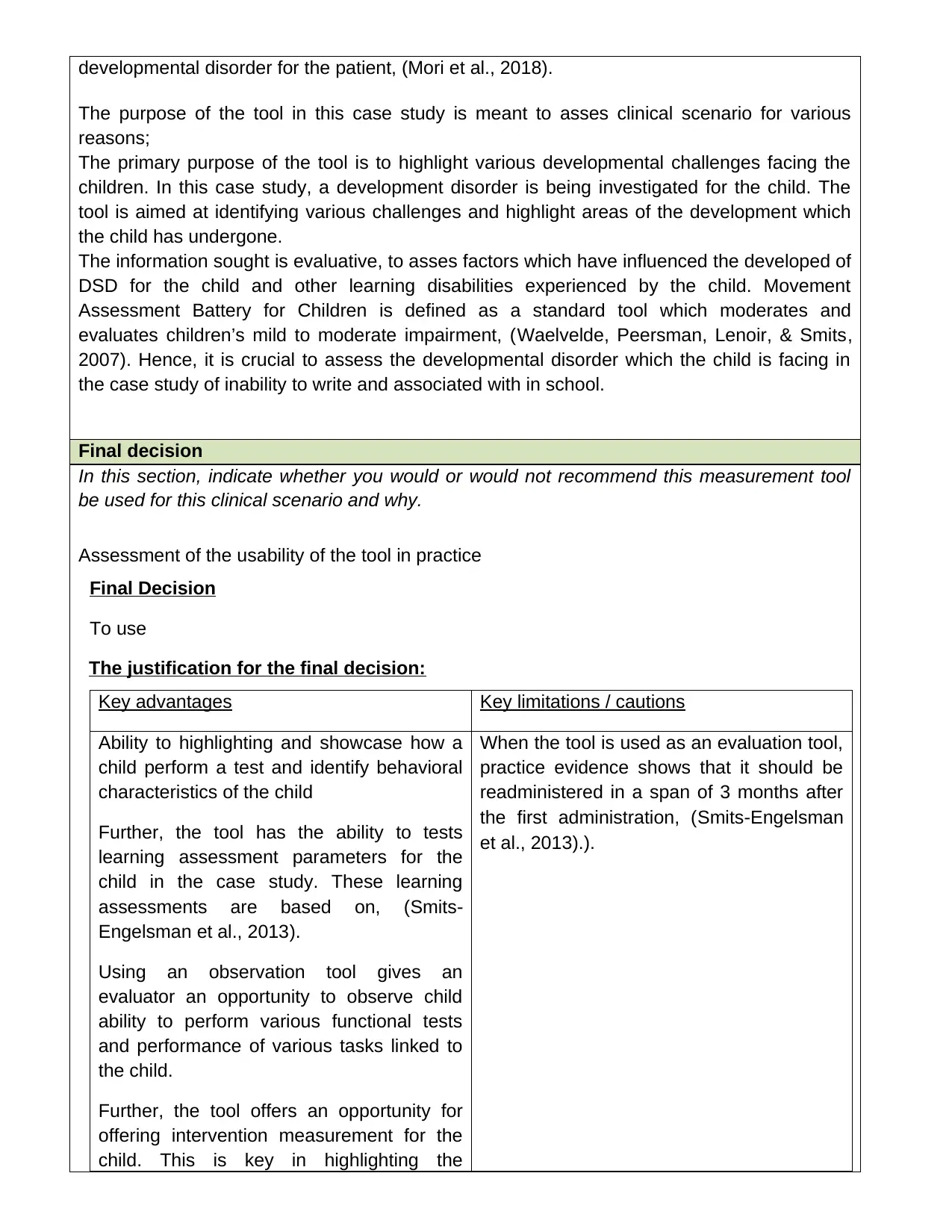
developmental disorder for the patient, (Mori et al., 2018).
The purpose of the tool in this case study is meant to asses clinical scenario for various
reasons;
The primary purpose of the tool is to highlight various developmental challenges facing the
children. In this case study, a development disorder is being investigated for the child. The
tool is aimed at identifying various challenges and highlight areas of the development which
the child has undergone.
The information sought is evaluative, to asses factors which have influenced the developed of
DSD for the child and other learning disabilities experienced by the child. Movement
Assessment Battery for Children is defined as a standard tool which moderates and
evaluates children’s mild to moderate impairment, (Waelvelde, Peersman, Lenoir, & Smits,
2007). Hence, it is crucial to assess the developmental disorder which the child is facing in
the case study of inability to write and associated with in school.
Final decision
In this section, indicate whether you would or would not recommend this measurement tool
be used for this clinical scenario and why.
Assessment of the usability of the tool in practice
Final Decision
To use
The justification for the final decision:
Key advantages Key limitations / cautions
Ability to highlighting and showcase how a
child perform a test and identify behavioral
characteristics of the child
Further, the tool has the ability to tests
learning assessment parameters for the
child in the case study. These learning
assessments are based on, (Smits‐
Engelsman et al., 2013).
Using an observation tool gives an
evaluator an opportunity to observe child
ability to perform various functional tests
and performance of various tasks linked to
the child.
Further, the tool offers an opportunity for
offering intervention measurement for the
child. This is key in highlighting the
When the tool is used as an evaluation tool,
practice evidence shows that it should be
readministered in a span of 3 months after
the first administration, (Smits‐Engelsman
et al., 2013).).
The purpose of the tool in this case study is meant to asses clinical scenario for various
reasons;
The primary purpose of the tool is to highlight various developmental challenges facing the
children. In this case study, a development disorder is being investigated for the child. The
tool is aimed at identifying various challenges and highlight areas of the development which
the child has undergone.
The information sought is evaluative, to asses factors which have influenced the developed of
DSD for the child and other learning disabilities experienced by the child. Movement
Assessment Battery for Children is defined as a standard tool which moderates and
evaluates children’s mild to moderate impairment, (Waelvelde, Peersman, Lenoir, & Smits,
2007). Hence, it is crucial to assess the developmental disorder which the child is facing in
the case study of inability to write and associated with in school.
Final decision
In this section, indicate whether you would or would not recommend this measurement tool
be used for this clinical scenario and why.
Assessment of the usability of the tool in practice
Final Decision
To use
The justification for the final decision:
Key advantages Key limitations / cautions
Ability to highlighting and showcase how a
child perform a test and identify behavioral
characteristics of the child
Further, the tool has the ability to tests
learning assessment parameters for the
child in the case study. These learning
assessments are based on, (Smits‐
Engelsman et al., 2013).
Using an observation tool gives an
evaluator an opportunity to observe child
ability to perform various functional tests
and performance of various tasks linked to
the child.
Further, the tool offers an opportunity for
offering intervention measurement for the
child. This is key in highlighting the
When the tool is used as an evaluation tool,
practice evidence shows that it should be
readministered in a span of 3 months after
the first administration, (Smits‐Engelsman
et al., 2013).).
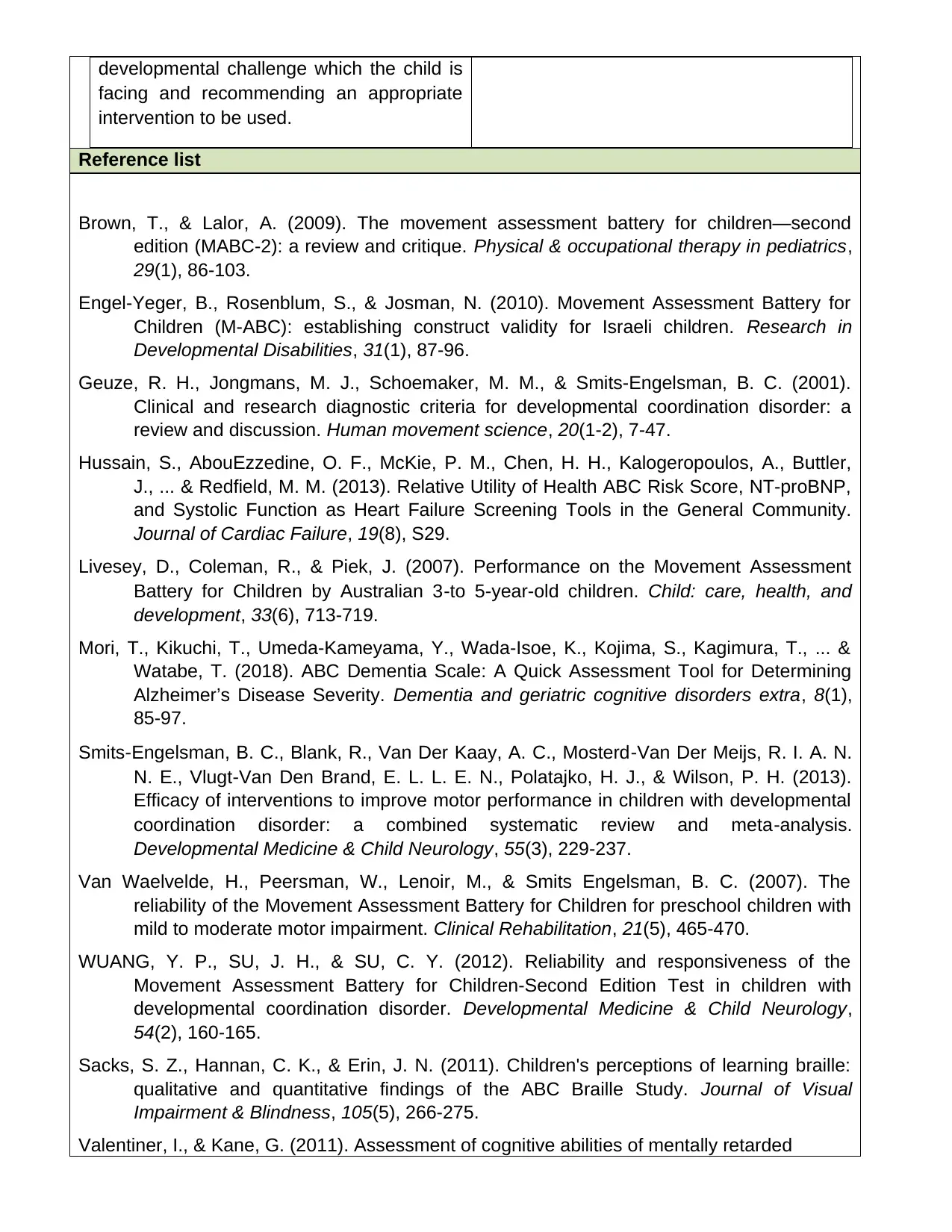
developmental challenge which the child is
facing and recommending an appropriate
intervention to be used.
Reference list
Brown, T., & Lalor, A. (2009). The movement assessment battery for children—second
edition (MABC-2): a review and critique. Physical & occupational therapy in pediatrics,
29(1), 86-103.
Engel-Yeger, B., Rosenblum, S., & Josman, N. (2010). Movement Assessment Battery for
Children (M-ABC): establishing construct validity for Israeli children. Research in
Developmental Disabilities, 31(1), 87-96.
Geuze, R. H., Jongmans, M. J., Schoemaker, M. M., & Smits-Engelsman, B. C. (2001).
Clinical and research diagnostic criteria for developmental coordination disorder: a
review and discussion. Human movement science, 20(1-2), 7-47.
Hussain, S., AbouEzzedine, O. F., McKie, P. M., Chen, H. H., Kalogeropoulos, A., Buttler,
J., ... & Redfield, M. M. (2013). Relative Utility of Health ABC Risk Score, NT-proBNP,
and Systolic Function as Heart Failure Screening Tools in the General Community.
Journal of Cardiac Failure, 19(8), S29.
Livesey, D., Coleman, R., & Piek, J. (2007). Performance on the Movement Assessment
Battery for Children by Australian 3‐to 5‐year‐old children. Child: care, health, and
development, 33(6), 713-719.
Mori, T., Kikuchi, T., Umeda-Kameyama, Y., Wada-Isoe, K., Kojima, S., Kagimura, T., ... &
Watabe, T. (2018). ABC Dementia Scale: A Quick Assessment Tool for Determining
Alzheimer’s Disease Severity. Dementia and geriatric cognitive disorders extra, 8(1),
85-97.
Smits‐Engelsman, B. C., Blank, R., Van Der Kaay, A. C., Mosterd‐Van Der Meijs, R. I. A. N.
N. E., Vlugt‐Van Den Brand, E. L. L. E. N., Polatajko, H. J., & Wilson, P. H. (2013).
Efficacy of interventions to improve motor performance in children with developmental
coordination disorder: a combined systematic review and meta‐analysis.
Developmental Medicine & Child Neurology, 55(3), 229-237.
Van Waelvelde, H., Peersman, W., Lenoir, M., & Smits Engelsman, B. C. (2007). The
reliability of the Movement Assessment Battery for Children for preschool children with
mild to moderate motor impairment. Clinical Rehabilitation, 21(5), 465-470.
WUANG, Y. P., SU, J. H., & SU, C. Y. (2012). Reliability and responsiveness of the
Movement Assessment Battery for Children-Second Edition Test in children with
developmental coordination disorder. Developmental Medicine & Child Neurology,
54(2), 160-165.
Sacks, S. Z., Hannan, C. K., & Erin, J. N. (2011). Children's perceptions of learning braille:
qualitative and quantitative findings of the ABC Braille Study. Journal of Visual
Impairment & Blindness, 105(5), 266-275.
Valentiner, I., & Kane, G. (2011). Assessment of cognitive abilities of mentally retarded
facing and recommending an appropriate
intervention to be used.
Reference list
Brown, T., & Lalor, A. (2009). The movement assessment battery for children—second
edition (MABC-2): a review and critique. Physical & occupational therapy in pediatrics,
29(1), 86-103.
Engel-Yeger, B., Rosenblum, S., & Josman, N. (2010). Movement Assessment Battery for
Children (M-ABC): establishing construct validity for Israeli children. Research in
Developmental Disabilities, 31(1), 87-96.
Geuze, R. H., Jongmans, M. J., Schoemaker, M. M., & Smits-Engelsman, B. C. (2001).
Clinical and research diagnostic criteria for developmental coordination disorder: a
review and discussion. Human movement science, 20(1-2), 7-47.
Hussain, S., AbouEzzedine, O. F., McKie, P. M., Chen, H. H., Kalogeropoulos, A., Buttler,
J., ... & Redfield, M. M. (2013). Relative Utility of Health ABC Risk Score, NT-proBNP,
and Systolic Function as Heart Failure Screening Tools in the General Community.
Journal of Cardiac Failure, 19(8), S29.
Livesey, D., Coleman, R., & Piek, J. (2007). Performance on the Movement Assessment
Battery for Children by Australian 3‐to 5‐year‐old children. Child: care, health, and
development, 33(6), 713-719.
Mori, T., Kikuchi, T., Umeda-Kameyama, Y., Wada-Isoe, K., Kojima, S., Kagimura, T., ... &
Watabe, T. (2018). ABC Dementia Scale: A Quick Assessment Tool for Determining
Alzheimer’s Disease Severity. Dementia and geriatric cognitive disorders extra, 8(1),
85-97.
Smits‐Engelsman, B. C., Blank, R., Van Der Kaay, A. C., Mosterd‐Van Der Meijs, R. I. A. N.
N. E., Vlugt‐Van Den Brand, E. L. L. E. N., Polatajko, H. J., & Wilson, P. H. (2013).
Efficacy of interventions to improve motor performance in children with developmental
coordination disorder: a combined systematic review and meta‐analysis.
Developmental Medicine & Child Neurology, 55(3), 229-237.
Van Waelvelde, H., Peersman, W., Lenoir, M., & Smits Engelsman, B. C. (2007). The
reliability of the Movement Assessment Battery for Children for preschool children with
mild to moderate motor impairment. Clinical Rehabilitation, 21(5), 465-470.
WUANG, Y. P., SU, J. H., & SU, C. Y. (2012). Reliability and responsiveness of the
Movement Assessment Battery for Children-Second Edition Test in children with
developmental coordination disorder. Developmental Medicine & Child Neurology,
54(2), 160-165.
Sacks, S. Z., Hannan, C. K., & Erin, J. N. (2011). Children's perceptions of learning braille:
qualitative and quantitative findings of the ABC Braille Study. Journal of Visual
Impairment & Blindness, 105(5), 266-275.
Valentiner, I., & Kane, G. (2011). Assessment of cognitive abilities of mentally retarded
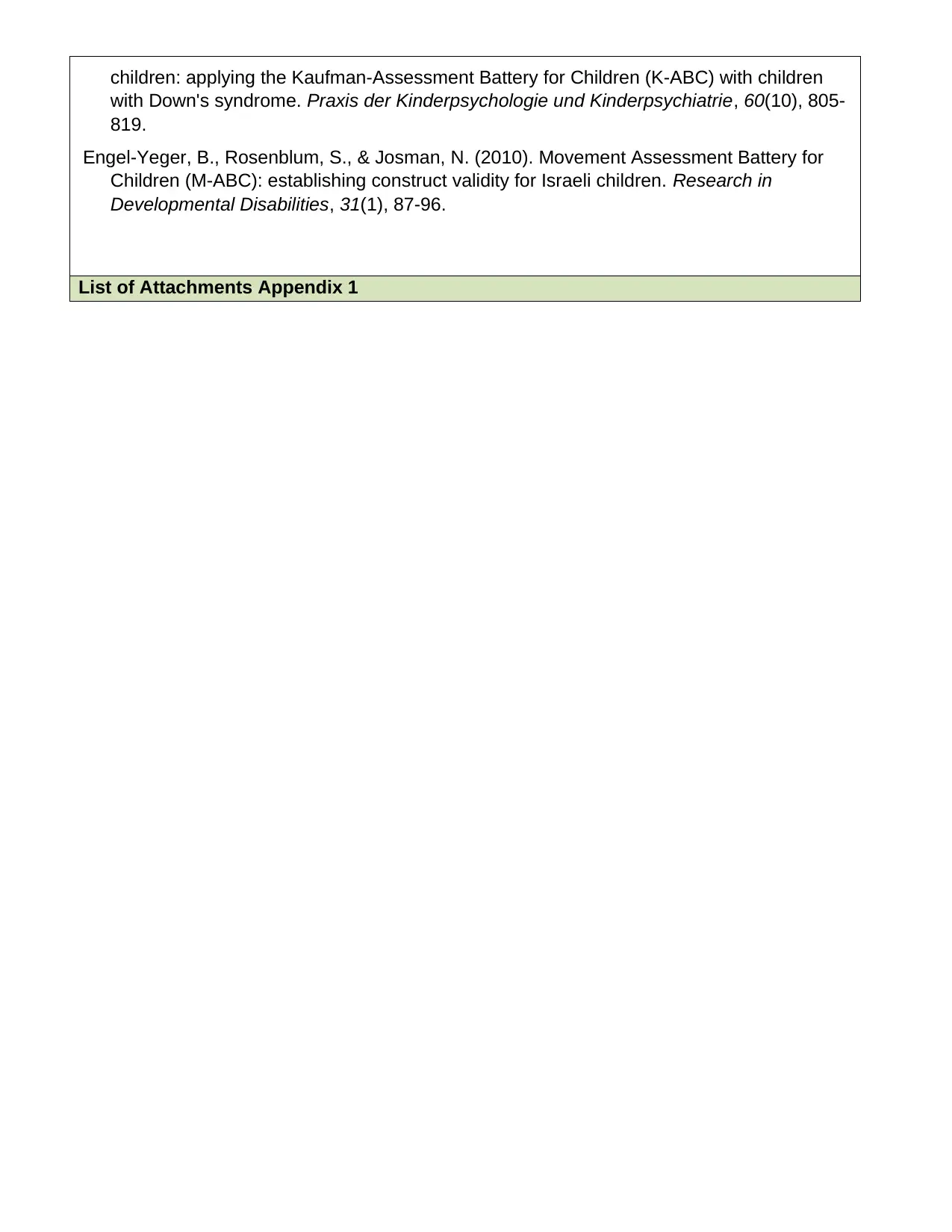
children: applying the Kaufman-Assessment Battery for Children (K-ABC) with children
with Down's syndrome. Praxis der Kinderpsychologie und Kinderpsychiatrie, 60(10), 805-
819.
Engel-Yeger, B., Rosenblum, S., & Josman, N. (2010). Movement Assessment Battery for
Children (M-ABC): establishing construct validity for Israeli children. Research in
Developmental Disabilities, 31(1), 87-96.
List of Attachments Appendix 1
with Down's syndrome. Praxis der Kinderpsychologie und Kinderpsychiatrie, 60(10), 805-
819.
Engel-Yeger, B., Rosenblum, S., & Josman, N. (2010). Movement Assessment Battery for
Children (M-ABC): establishing construct validity for Israeli children. Research in
Developmental Disabilities, 31(1), 87-96.
List of Attachments Appendix 1
Paraphrase This Document
Need a fresh take? Get an instant paraphrase of this document with our AI Paraphraser
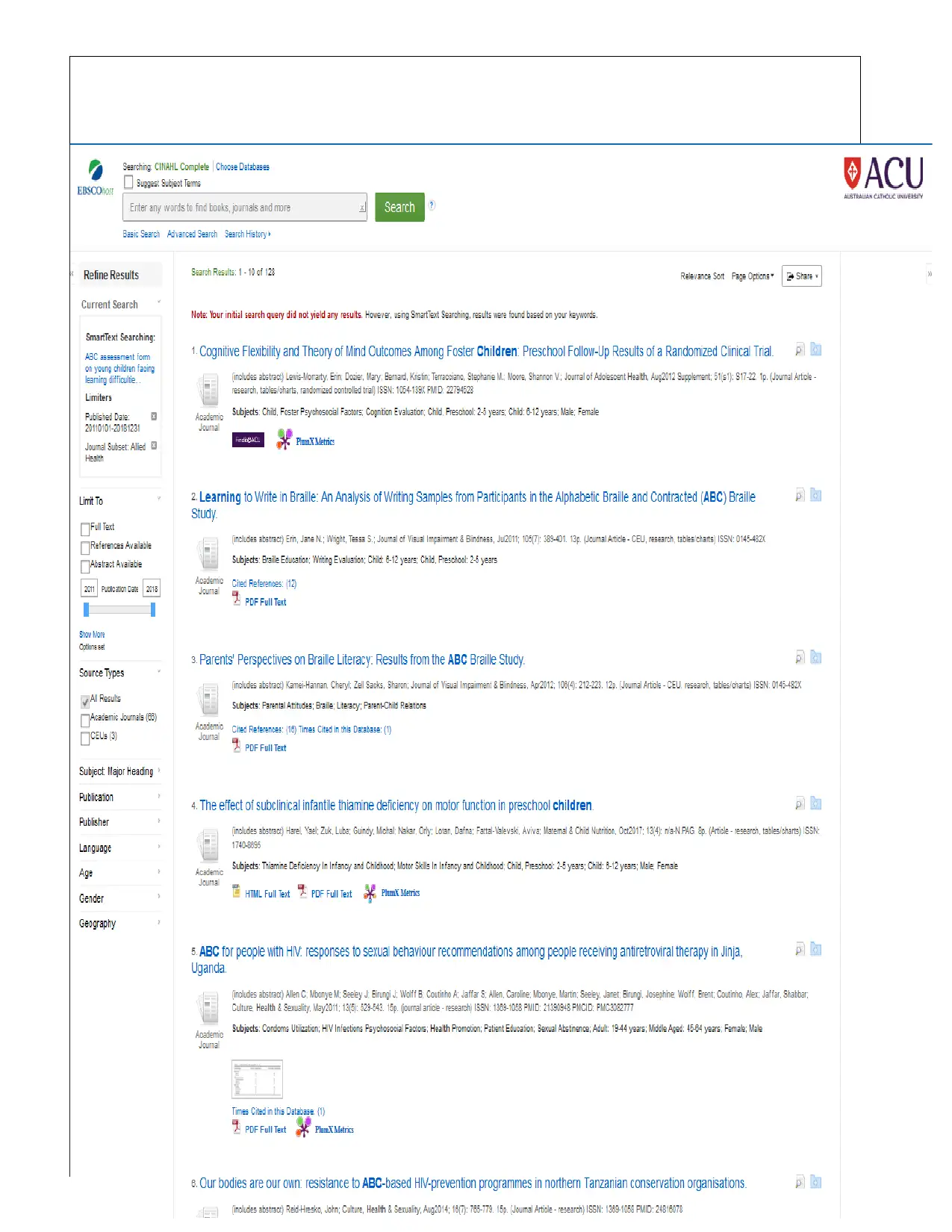
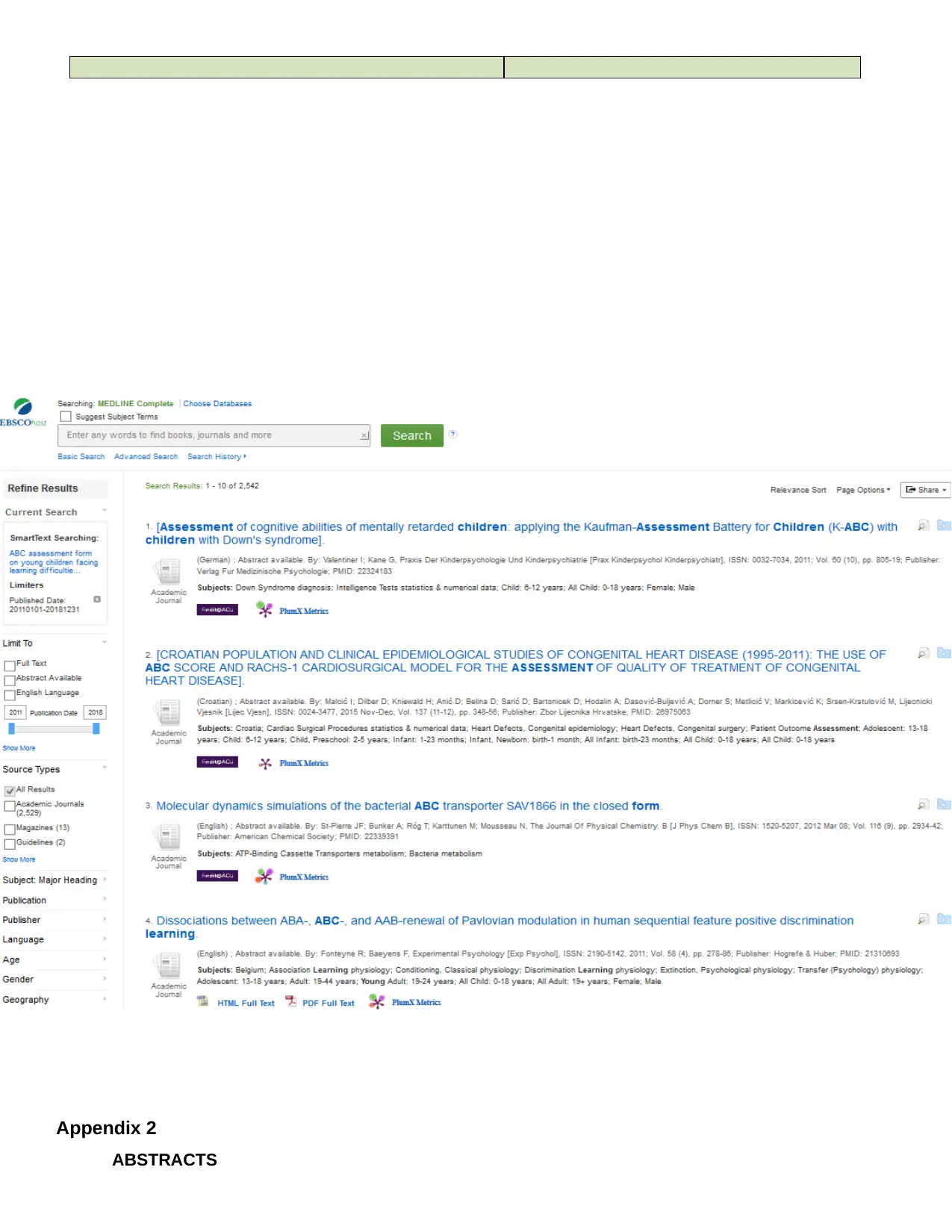
Appendix 2
ABSTRACTS
ABSTRACTS
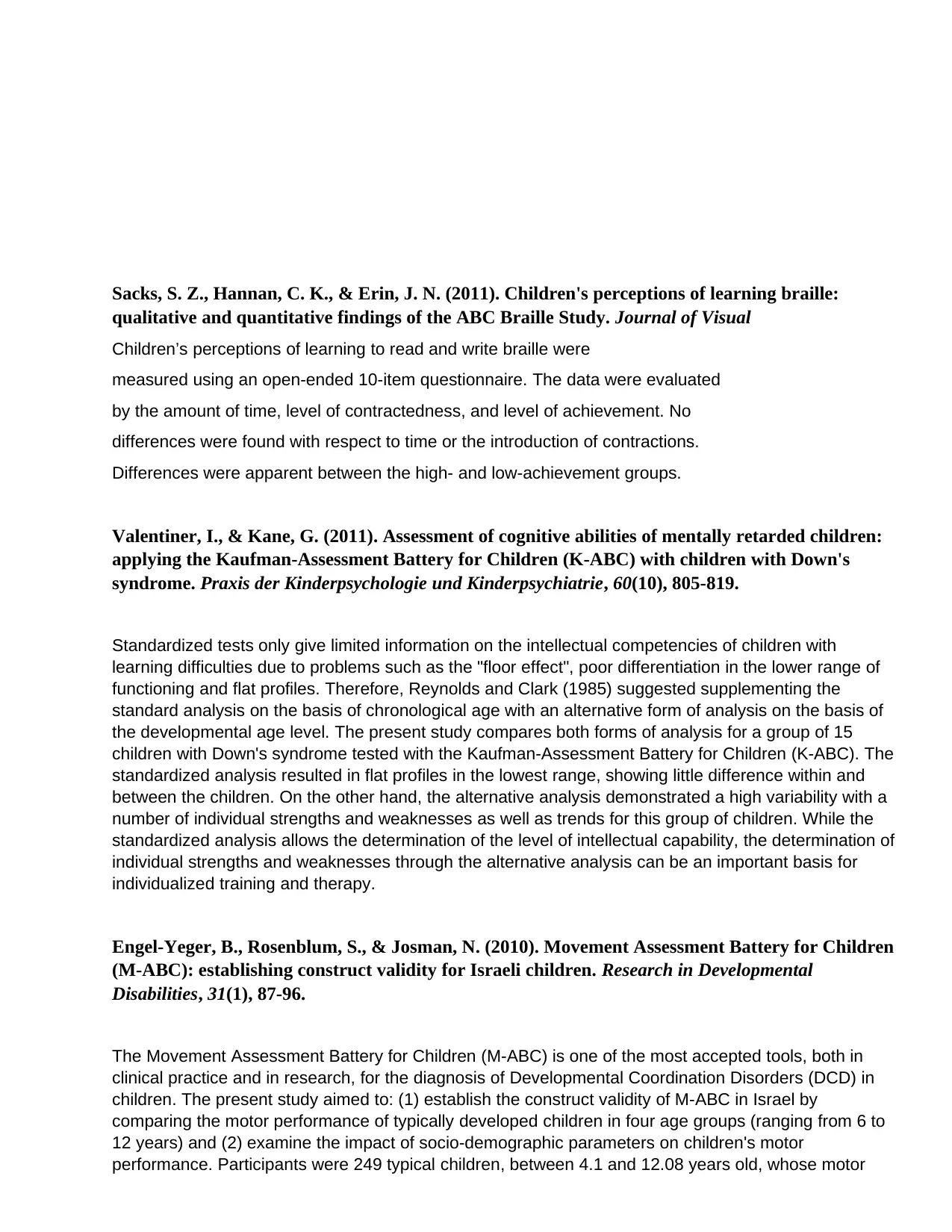
Sacks, S. Z., Hannan, C. K., & Erin, J. N. (2011). Children's perceptions of learning braille:
qualitative and quantitative findings of the ABC Braille Study. Journal of Visual
Children’s perceptions of learning to read and write braille were
measured using an open-ended 10-item questionnaire. The data were evaluated
by the amount of time, level of contractedness, and level of achievement. No
differences were found with respect to time or the introduction of contractions.
Differences were apparent between the high- and low-achievement groups.
Valentiner, I., & Kane, G. (2011). Assessment of cognitive abilities of mentally retarded children:
applying the Kaufman-Assessment Battery for Children (K-ABC) with children with Down's
syndrome. Praxis der Kinderpsychologie und Kinderpsychiatrie, 60(10), 805-819.
Standardized tests only give limited information on the intellectual competencies of children with
learning difficulties due to problems such as the "floor effect", poor differentiation in the lower range of
functioning and flat profiles. Therefore, Reynolds and Clark (1985) suggested supplementing the
standard analysis on the basis of chronological age with an alternative form of analysis on the basis of
the developmental age level. The present study compares both forms of analysis for a group of 15
children with Down's syndrome tested with the Kaufman-Assessment Battery for Children (K-ABC). The
standardized analysis resulted in flat profiles in the lowest range, showing little difference within and
between the children. On the other hand, the alternative analysis demonstrated a high variability with a
number of individual strengths and weaknesses as well as trends for this group of children. While the
standardized analysis allows the determination of the level of intellectual capability, the determination of
individual strengths and weaknesses through the alternative analysis can be an important basis for
individualized training and therapy.
Engel-Yeger, B., Rosenblum, S., & Josman, N. (2010). Movement Assessment Battery for Children
(M-ABC): establishing construct validity for Israeli children. Research in Developmental
Disabilities, 31(1), 87-96.
The Movement Assessment Battery for Children (M-ABC) is one of the most accepted tools, both in
clinical practice and in research, for the diagnosis of Developmental Coordination Disorders (DCD) in
children. The present study aimed to: (1) establish the construct validity of M-ABC in Israel by
comparing the motor performance of typically developed children in four age groups (ranging from 6 to
12 years) and (2) examine the impact of socio-demographic parameters on children's motor
performance. Participants were 249 typical children, between 4.1 and 12.08 years old, whose motor
qualitative and quantitative findings of the ABC Braille Study. Journal of Visual
Children’s perceptions of learning to read and write braille were
measured using an open-ended 10-item questionnaire. The data were evaluated
by the amount of time, level of contractedness, and level of achievement. No
differences were found with respect to time or the introduction of contractions.
Differences were apparent between the high- and low-achievement groups.
Valentiner, I., & Kane, G. (2011). Assessment of cognitive abilities of mentally retarded children:
applying the Kaufman-Assessment Battery for Children (K-ABC) with children with Down's
syndrome. Praxis der Kinderpsychologie und Kinderpsychiatrie, 60(10), 805-819.
Standardized tests only give limited information on the intellectual competencies of children with
learning difficulties due to problems such as the "floor effect", poor differentiation in the lower range of
functioning and flat profiles. Therefore, Reynolds and Clark (1985) suggested supplementing the
standard analysis on the basis of chronological age with an alternative form of analysis on the basis of
the developmental age level. The present study compares both forms of analysis for a group of 15
children with Down's syndrome tested with the Kaufman-Assessment Battery for Children (K-ABC). The
standardized analysis resulted in flat profiles in the lowest range, showing little difference within and
between the children. On the other hand, the alternative analysis demonstrated a high variability with a
number of individual strengths and weaknesses as well as trends for this group of children. While the
standardized analysis allows the determination of the level of intellectual capability, the determination of
individual strengths and weaknesses through the alternative analysis can be an important basis for
individualized training and therapy.
Engel-Yeger, B., Rosenblum, S., & Josman, N. (2010). Movement Assessment Battery for Children
(M-ABC): establishing construct validity for Israeli children. Research in Developmental
Disabilities, 31(1), 87-96.
The Movement Assessment Battery for Children (M-ABC) is one of the most accepted tools, both in
clinical practice and in research, for the diagnosis of Developmental Coordination Disorders (DCD) in
children. The present study aimed to: (1) establish the construct validity of M-ABC in Israel by
comparing the motor performance of typically developed children in four age groups (ranging from 6 to
12 years) and (2) examine the impact of socio-demographic parameters on children's motor
performance. Participants were 249 typical children, between 4.1 and 12.08 years old, whose motor
Secure Best Marks with AI Grader
Need help grading? Try our AI Grader for instant feedback on your assignments.
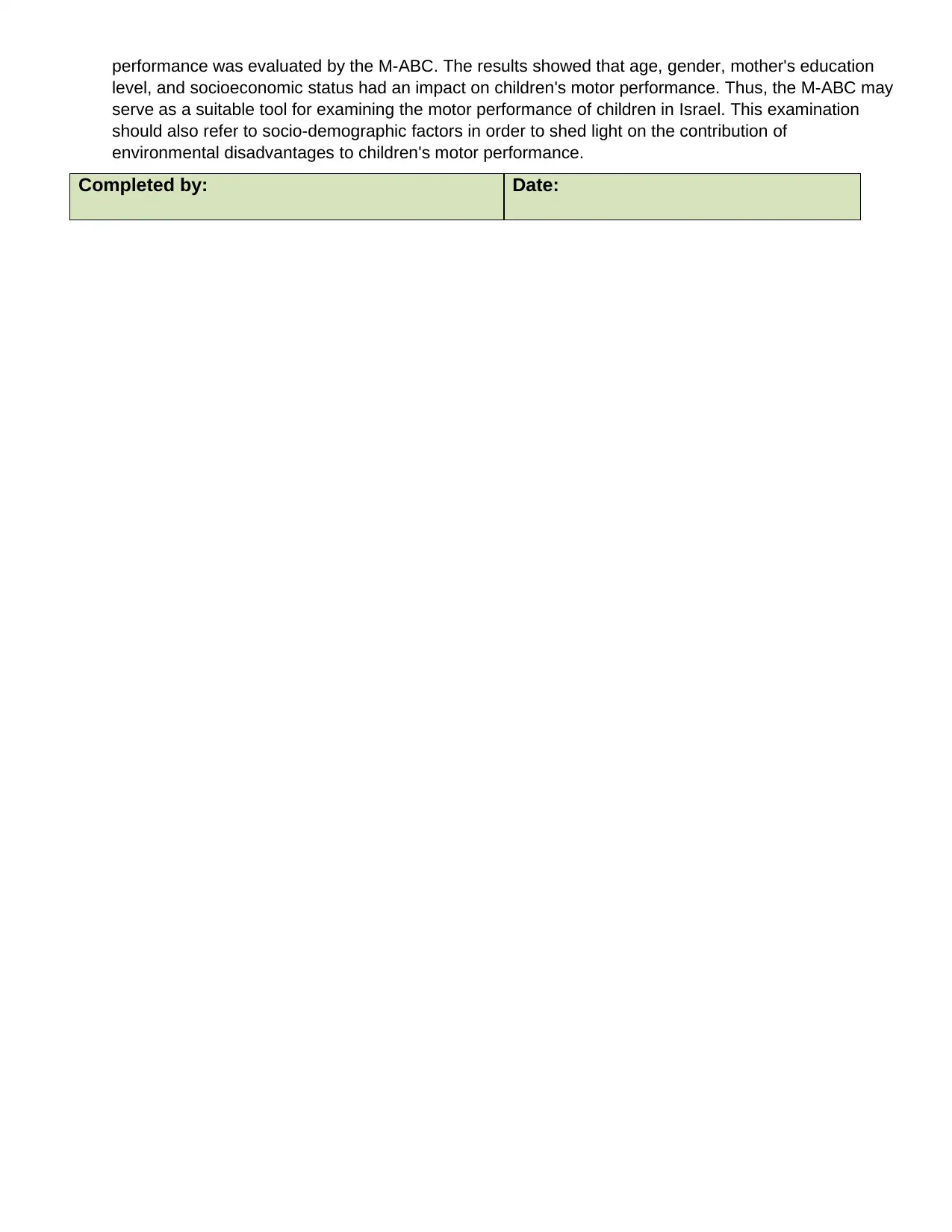
performance was evaluated by the M-ABC. The results showed that age, gender, mother's education
level, and socioeconomic status had an impact on children's motor performance. Thus, the M-ABC may
serve as a suitable tool for examining the motor performance of children in Israel. This examination
should also refer to socio-demographic factors in order to shed light on the contribution of
environmental disadvantages to children's motor performance.
Completed by: Date:
level, and socioeconomic status had an impact on children's motor performance. Thus, the M-ABC may
serve as a suitable tool for examining the motor performance of children in Israel. This examination
should also refer to socio-demographic factors in order to shed light on the contribution of
environmental disadvantages to children's motor performance.
Completed by: Date:
1 out of 11
Related Documents
Your All-in-One AI-Powered Toolkit for Academic Success.
+13062052269
info@desklib.com
Available 24*7 on WhatsApp / Email
![[object Object]](/_next/static/media/star-bottom.7253800d.svg)
Unlock your academic potential
© 2024 | Zucol Services PVT LTD | All rights reserved.





